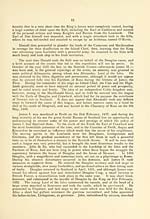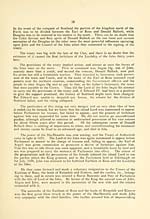Organisations > Clan Donald roll of honour
(18) Page 14
Download files
Complete book:
Individual page:
Thumbnail gallery: Grid view | List view

14
through Moray to Castle Ruthven, which he burned to the ground. The King
was too much occupied in his efforts to suppress Douglas to devote attention to
John, although there is no doubt that he contemplated proceeding north to suppress
the rising there. In the meantime, however, John and his Clansmen remained
immune from James's vengeance, holding their power in the Highlands, and
enlivening their days with " creachs " against the MacKenzies, MacKays, and
Sutherlands.
The struggle between the Douglases and Stewarts ended in the defeat of the
former at Arkinholme, and Douglas was declared traitor. He betook himself to
Argyllshire, where he was received by Donald Balloch at the Castle of Dunstaffnage.
Here they were joined by the Lord of the Isles who had come down from the North,
and they agreed to make another effort against James. Douglas crossed to
England, where he was cordially received by the Duke of York, while MacDonald
prepared for an invasion of the King's lands. He collected a fleet of 100 galleys
and a force of 5,000 men, and placed Donald Balloch in command. Donald
proceeded to Inverkip, where he landed his army, and carried fire and sword into
the heart of Ayrshire. He met with little resistance and carried away an immense
booty. Returning to Inverkip he directed his course to Arran, where he attacked
Brodick Castle, burning it to the ground. He invaded the Cumbraes and Bute,
and having taken the castle of Rothesay, made himself master of Bute. He
concluded this expedition by an attack on the Bishop of Lismore, who had made
himself obnoxious by affixing his seal to the forfeiture of the Douglases, and after
having killed most of his attendants, forced the Bishop to take refuge in a
sanctuary which scarcely protected him from the fury of his enemies. The ex-
pedition of Donald Balloch failed in its purpose of fortifying the Douglas cause,
and the suppression of the family and the banishment of the Earl is familiar history.
The Lord of the Isles, finding himself alone in his opposition, made his peace
with James, and we find him during the rest of James's lifetime in close contact
with the Scottish Court and employed by the King in various capacities, the
principal object of these being to keep him as far from the Isles as possible.
It is of the greatest importance to those interested in the history of the Clan
to observe closely the position of the Clan at the time of which we write. Although
divided a little as the result of the two marriages of John of Isla, the Clan was still
a unity and the possessions held by the principal families were a noble patrimony,
and it would have been well for themselves and their posterity had they held them-
selves aloof from the quarrels and intrigues of the Scottish nobility. The Celtic
tradition was deep in their blood, however, and always at the back of their minds
was the idea of an independent Celtic kingdom. They owed no real loyalty to
the reigning family of Scotland and were ever ready to seize any opportunity to
further their idea of independence. The time now seemed favourable, and we
must consider the events that led to the " Treaty of Ardtornish."
The untimely death of James II. at the siege of Roxburgh once more plunged
Scotland into the difficulties inherent upon a minority. The banished Earl of
Douglas, in exile at the English Court, watched with deepest interest the course of
events in Scotland and left no means unused by which he could regain the co-opera-
tion of the Lord of the Isles. He gained the ear of Edward IV., and overtures
were made to the Island Lord by commissioners from England which resulted in
the " Treaty of Ardtornish."
The provisions of this treaty were that the Lords of the Isles were to become
vassals of England, and to assist Edward IV. in his wars in Ireland and elsewhere.
through Moray to Castle Ruthven, which he burned to the ground. The King
was too much occupied in his efforts to suppress Douglas to devote attention to
John, although there is no doubt that he contemplated proceeding north to suppress
the rising there. In the meantime, however, John and his Clansmen remained
immune from James's vengeance, holding their power in the Highlands, and
enlivening their days with " creachs " against the MacKenzies, MacKays, and
Sutherlands.
The struggle between the Douglases and Stewarts ended in the defeat of the
former at Arkinholme, and Douglas was declared traitor. He betook himself to
Argyllshire, where he was received by Donald Balloch at the Castle of Dunstaffnage.
Here they were joined by the Lord of the Isles who had come down from the North,
and they agreed to make another effort against James. Douglas crossed to
England, where he was cordially received by the Duke of York, while MacDonald
prepared for an invasion of the King's lands. He collected a fleet of 100 galleys
and a force of 5,000 men, and placed Donald Balloch in command. Donald
proceeded to Inverkip, where he landed his army, and carried fire and sword into
the heart of Ayrshire. He met with little resistance and carried away an immense
booty. Returning to Inverkip he directed his course to Arran, where he attacked
Brodick Castle, burning it to the ground. He invaded the Cumbraes and Bute,
and having taken the castle of Rothesay, made himself master of Bute. He
concluded this expedition by an attack on the Bishop of Lismore, who had made
himself obnoxious by affixing his seal to the forfeiture of the Douglases, and after
having killed most of his attendants, forced the Bishop to take refuge in a
sanctuary which scarcely protected him from the fury of his enemies. The ex-
pedition of Donald Balloch failed in its purpose of fortifying the Douglas cause,
and the suppression of the family and the banishment of the Earl is familiar history.
The Lord of the Isles, finding himself alone in his opposition, made his peace
with James, and we find him during the rest of James's lifetime in close contact
with the Scottish Court and employed by the King in various capacities, the
principal object of these being to keep him as far from the Isles as possible.
It is of the greatest importance to those interested in the history of the Clan
to observe closely the position of the Clan at the time of which we write. Although
divided a little as the result of the two marriages of John of Isla, the Clan was still
a unity and the possessions held by the principal families were a noble patrimony,
and it would have been well for themselves and their posterity had they held them-
selves aloof from the quarrels and intrigues of the Scottish nobility. The Celtic
tradition was deep in their blood, however, and always at the back of their minds
was the idea of an independent Celtic kingdom. They owed no real loyalty to
the reigning family of Scotland and were ever ready to seize any opportunity to
further their idea of independence. The time now seemed favourable, and we
must consider the events that led to the " Treaty of Ardtornish."
The untimely death of James II. at the siege of Roxburgh once more plunged
Scotland into the difficulties inherent upon a minority. The banished Earl of
Douglas, in exile at the English Court, watched with deepest interest the course of
events in Scotland and left no means unused by which he could regain the co-opera-
tion of the Lord of the Isles. He gained the ear of Edward IV., and overtures
were made to the Island Lord by commissioners from England which resulted in
the " Treaty of Ardtornish."
The provisions of this treaty were that the Lords of the Isles were to become
vassals of England, and to assist Edward IV. in his wars in Ireland and elsewhere.
Set display mode to: Large image | Transcription
Images and transcriptions on this page, including medium image downloads, may be used under the Creative Commons Attribution 4.0 International Licence unless otherwise stated. ![]()
| Rolls of honour > Organisations > Clan Donald roll of honour > (18) Page 14 |
|---|
| Permanent URL | https://digital.nls.uk/100224988 |
|---|---|
| Description | Listed alphabetically. |
|---|

